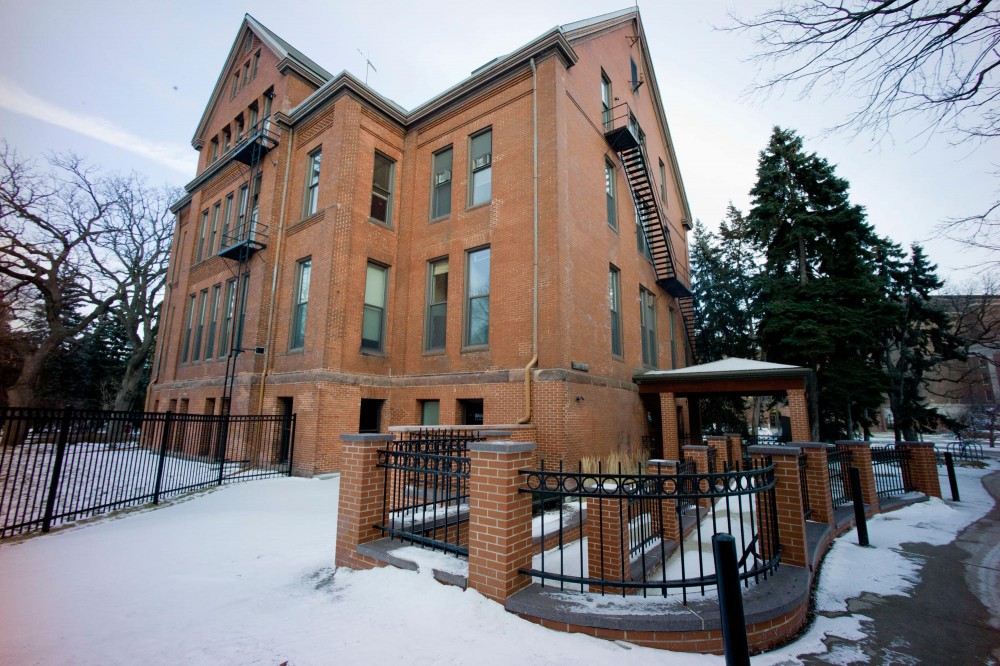The doors of Eddy Hall might stay shut for another year.
The University asked for $21 million in its capital request bill in October to renovate the campusâÄô oldest standing building and decommission other buildings. But Gov. Mark DaytonâÄôs proposed bonding bill cut the UniversityâÄôs total request by more than half and left the Eddy Hall project with nothing from the state.
Built in 1886, Eddy Hall needs to be âÄúcompletely reconfiguredâÄù said Dean Carlson, a capital planner for the Capital Planning and Project Management department.
While the inside would be changed significantly, Carlson said that the outside of the building would remain largely intact because of its history.
The proposal would relocate the admissions department âÄî specifically for international and transfer students âÄî from Williamson Hall to Eddy Hall, Carlson said. This would bring admissions closer to its other headquarters at Jones Hall.
Jones and Eddy are both historic buildings that have âÄúa nice feelâÄù to them, which gives incoming freshmen âÄúa really good sense of the University,âÄù Carlson said.
The plan would also allow the University to empty out Williamson Hall, which is on the UniversityâÄôs blacklist for buildings to demolish. The University requested $3 million for âÄúspace optimization,âÄù which would decommission two major East Bank facilities, Fraser Hall and Williamson Hall.
If the money comes through this legislative session, Eddy Hall would be under design for six months and construction would take 14 months, Carlson said.
But if the plan is cut off from this yearâÄôs bonding bill, the University would keep Eddy Hall shut for another year in hopes of funding the project at a later date.
âÄúIn the past for projects that werenâÄôt funded, weâÄôve basically tried again the next time. We really donâÄôt have the funds for it,âÄù Carlson said. âÄúWeâÄôre really hoping to get in on the 2012 [bonding bill].âÄù
âÄòCrumbling at the foundationâÄô
After twice being excluded from state bonding bills, another of the UniversityâÄôs construction projects âÄî the Itasca Biological Station and Laboratories âÄî is looking more promising for this legislative session.
DaytonâÄôs bonding bill proposal would give the University the $4 million it requested for renovating the Itasca facilities âÄî a $6 million project. DaytonâÄôs proposal, which will likely go through drastic changes during the legislative session, also included $54 million for renovating the Old Main Utility Building.
This is the third time funds for the Itasca facilities have been requested from the state, College of Biological Sciences Dean Robert Elde said. Two years ago, former Gov. Tim Pawlenty line-item vetoed the request after it was approved by the Legislature. The funds were not included on the bonding bill signed at the end of last summerâÄôs state government shutdown.
Money to Itasca would mean building a new student center, which would include classroom labs, an auditorium, âÄúthinking-writingâÄù rooms and administrative offices, Elde said.
The project has received donations of $1.5 million from private supporters, Elde said.
âÄúItâÄôs pretty rare for a building project to have that much support from alumni and donors,âÄù he said. âÄúOur alumni and donors have spoken with their wallets in support of this thing.âÄù
The Itasca stations are used most heavily in the summer, specifically for âÄúNature of LifeâÄù âÄî a three-day course required of all incoming CBS freshmen. The stations are also used for field research such as the Mississippi Metagenome Project, a project which studies microorganisms found in the Mississippi River.
The site celebrated its 100th anniversary in 2009.
âÄúMost of the buildings were built after the second World War,âÄù Elde said, noting that the design of the rooms is more like army barracks than âÄústurdy classrooms.âÄù
Resident Manager of the Itasca facilities Charlie Schmidgall said that the facilities are predominantly used in the summer because they arenâÄôt equipped for winter weather and are not up to energy efficiency standards.
âÄúA lot these buildings were put together in the 1940s and theyâÄôre beyond their service-life,âÄù Schmidgall said. He said that some of these facilities are âÄúcrumbling at the foundation.âÄù
âÄúItâÄôs been an ongoing problem for decades,âÄù Elde said, adding that the needs of the facilities have expanded as the demand for CBS admissions rises.
The station is unique because of its location on Lake Itasca, the headwaters of the Mississippi River.
âÄúEcologically, biologically and historically, itâÄôs an iconic place,âÄù Elde said.


